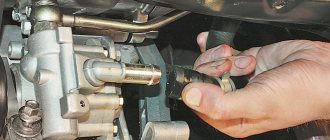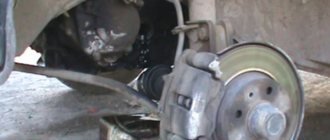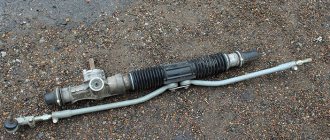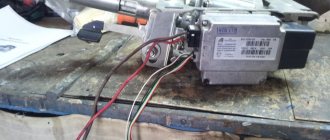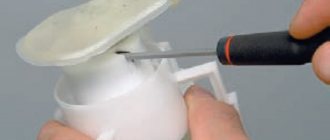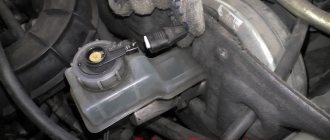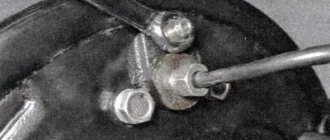In recent years, everyone who came to us with the problem of vibration (hum) in the power steering system was faced with the purchase of counterfeit high-pressure hoses (not original ones). Many of them replaced more than one set of hoses, and even managed to change the power steering mechanism and power steering pump in search of a problem, and the cost of the components does not always tell us about counterfeit: someone paid 1,100 rubles. for a set of hoses, and for some 2000 rubles. Here are examples of some requests to us:
- Hello! I own a VAZ 21123 car with power steering of your production. The other day I discovered mechanical damage to the steering rack boot, I decided to replace the boot and the high pressure hoses (2110-3408100-20 and 2110-3408018-20). After this, strong vibration and noise appeared when the steering wheel was quickly turned to the left, and sometimes it also occurs when turning right. The high pressure hose vibrates strongly. Sergey K.
-Hello. I'm interested in one question: I have a VAZ 2111 2008. After replacing the high pressure hose, I purchased the hose from a nearby store, the hose was VAZ 2110.2170. When turning the steering wheel, there was a vibration in the body and a strong noise; the car service center recommended purchasing old-style hoses. Roman Sh.
-I bought high pressure hoses with the same markings on both hoses 20MPA 101208 211010010 RS. And when turning left there is a vibration. What did I even buy? Vladimir
-Hello. There is a problem, please tell me what the problem is. 1. A VAZ 21124 car, when driving around a corner in the city at low speeds of 30-40 km/h, vibration is transmitted to the steering wheel (left or right turn, it doesn’t matter) and in the cabin you can hear the sound brrrrr brrrrr brrr. Tell me, what could it be? They checked the steering and ball joints, everything is in order. 2. When you stand still, vibration is transmitted to the body, and if you turn the steering wheel a little, it disappears for 20 seconds, then appears again. Also, when you turn the steering wheel, there is some kind of sound like Uuuuuuu. Could these problems be related to the pump? Vladimir.
These are just a few examples of the hundreds of car enthusiasts who contacted us. The problem with vibration is the absence of a throttle (vibration damper) under the ferrule, which is located in the middle of the high-pressure hose. The power steering pump creates uneven pressure in the system, the throttle is used to equalize this pressure. Many people ask how to distinguish an original high-pressure power steering hose from a counterfeit one, after analyzing the photographs that customers sent us: we found clear differences:
1. In the original NEW SAMPLE hoses, the fitting at the ends of the hose has a triple crimp, and on counterfeit ones it has a double crimp.
2. Since 2015, the plant has been producing NEW SAMPLE high-pressure hoses with yellow braiding, but not counterfeit ones.
3. ROMANIA is stamped on the fitting of the original hose, there is also a paint mark when passing through production quality control, but not on counterfeit ones.
4. The difference is in the stamping of the crimp sleeve in the middle of the hose.
We hope this article will help you understand the causes of car malfunctions and navigate correctly when searching for and purchasing high-pressure power steering hoses, so as not to overpay money and waste your time. Please note that the article discusses NEW SAMPLE hoses, since they are the ones that are most often counterfeited. Many people are interested in the difference between new and old hoses. They are interchangeable; the old-style hoses have a high-pressure tube that is not rolled, so the process of replacing these hoses is less time-consuming and expensive than new-style hoses, the tube of which is rolled, as a result of which it is necessary to remove and install the steering mechanism. Have a good trip!
Driving a car used to be quite a difficult task. The power steering, also known as power steering, of the Lada Priora makes the steering wheel of the car light. The electric booster is even lighter, but not more informative. Priora has configurations with EUR and power steering. The amplifier operates using liquid, so in comparison with an electric amplifier, you need to monitor the level. On Priora, the assembled part will cost more than 7 thousand. The price is for the kit - it consists of 11 parts. Constantly being on the road tires you not only with emotional fatigue, but also with the incessant movement of the steering wheel, gear lever and pressing the pedals. To reduce the load on muscles, various systems are built into cars. Some of them make the pedals “lighter”, while others make it easier to turn the steering wheel.
Standard power steering (hydraulic booster) - article number and price
The standard power steering for the Priora received catalog number 21230340701200, the cost is from 7,500 rubles. Before ordering and purchasing, you should check the availability of fasteners. But the system itself is sold for spare parts:
- Long oil tank strap - 21100341010500 - about 500 rubles.
- Oil tank bracket - 21100341010000 - about 150 rubles.
- Power steering tank - 21230341001000 - about 900 rubles.
- Supply pipe - 21100340812500 - about 1,000 rubles.
- Power steering pump - 21100340700900 - about 6,000 rubles.
- Pillow – 21100340804000 – about 400 rubles.
- Low pressure pipe – 21100340804000 – about 400 rub.
- High pressure hose with tube – 2110034801810 – about 1,900 RUR.
- High pressure pipe – 21100340808001 – about 900 rub.
- Low pressure hose with tube – 21100340802600 – about 1,800 RUR.
- Front high pressure hose – 21100340810010 – about 1600 rub.
What does the power steering system consist of and how does it work?
The Priora's power steering works in the steering system. Its main part is the pump. The system fluid circulates in a special tank, pipes, and hoses that can withstand high pressure.
The operation of the hydraulic booster depends on the quality and “purity” of the corresponding working fluid in the system. When the driver turns the steering wheel, the pump increases the pressure of the working fluid, and it pushes the piston, increasing the force on the steering rack. In this case, the force that develops thanks to the pump is proportional to the resistance force that acts on the wheels - be it off-road or on a free track.
It turns out that at high speed the Priora’s hydraulic booster practically does not work - changing lanes or turning requires the least effort. A special torsion bar device, which is part of the steering mechanism, helps to properly distribute the resulting forces. Having received a signal in time that the created pressure is sufficient, the pump stops its operation, and sufficient auxiliary force is created to turn the steering wheel. It turns out that while driving, the driver constantly needs to act on the steering wheel with the same force, because the power steering always minimizes the impact of the opposing force.
New sample power steering high pressure hoses for VAZ 2110, Priora, Kalina
Many drivers began their driving careers by driving a domestic car equipped with a steering column or steering rack. Having got behind the wheel of more modern domestic cars, drivers experience incredible relief from the ease of handling the steering wheel. The explanation for this benefit is power steering (power steering).
Hydraulic power steering (power steering) is an automotive hydraulic system, part of the steering mechanism, designed to facilitate control of the direction of movement of the vehicle while maintaining the necessary “feedback” and ensuring stability and unambiguity of the specified trajectory.
1 — Oil tank fastening tape (21100-3410105-00); 2 — Oil tank bracket (21100-3410100-00 / 21100-3410100-01); 3 — Oil tank (21230-3410010-00); 4 — Screw clamp (21080-1300080-50); 5 — Supply hose 800 (21100-3408124-00); 6 — Screw clamp (21080-1300080-60); 7 - Bracket (21100-3408159-10); 8 — Bolt M16x1.5 high pressure hose (21230-3408144-00); 9 — Washer 16 (00001-0002570-60); 10 — + Power steering oil pump assembly (21100-3407009-00 *); 11 — Bolt M6x25 (00001-0009026-21); 12 – Bracket (21100-3408159-00); 13 — Cushion bracket (21100-3408157-00); 14 - Low pressure pipe (21100-3408040-00); 15 — Washer 14 (00001-0002800-60); 16 — Bolt M14x1.5 high pressure hose (21100-3408070-00); 17 — Bolt M16x1.5 low pressure hose (21100-3408074-00); 18 — High pressure hose with a new sample tube (21100-3408018-20); 19 - High pressure pipe (21100-3408080-20); 20 — + 21100-3408026-00); 21 - Bracket 24 (00001-0045702-80); 22 — New front high-pressure hose (21100-3408100-20); 23 — Bottom bolt (21120-1001371-00 *); 24 - Middle bolt (21120-1001376-00 *).
Power steering is a modernized steering rack. The following parts were added to its simple design: Oil pump; Tank with working fluid; Spool valve; Power hydraulic cylinder; Pressure regulator; Connectors and hoses.
Depending on the year of manufacture, the “ten” can be equipped with a hydraulic booster (power steering) or an electric booster (electric power steering). These are completely different units. To understand the main differences, it is enough to study the hydraulic booster. Its main component is a pump driven by the crankshaft, it is integrated with other parts. The operating principle of the hydraulic booster is based on hydraulics.
If the car is stationary, moving straight, the pump pumps idle hydraulic oil inside the system. When the steering wheel begins to move, the torsion bar begins to twist, and the spool rotates relative to the distribution sleeve. At the same time, connecting hoses open, through which oil from the tank enters a certain chamber in the power cylinder (this depends on which direction the car maneuvers under the influence of turning the steering wheel). And from another chamber, hydraulic oil simultaneously enters the tank through open ducts. The cylinder piston moves the steering rack, while simultaneously transmitting force to the steering rods that turn the wheels.
The power steering is designed in such a way that if the power steering fails, the steering continues to work (although the steering wheel becomes heavier).
If the car maneuvers at low speed, then the efficiency of the power steering is maximum. This is achieved by increasing the number of revolutions of the pump motor. An increase in its performance contributes to an intensive flow of hydraulic fluid into the cylinder and the force applied to turning the steering wheel decreases significantly. Increasing the speed of the machine reduces the rotation speed of the electric motor, and the solenoid valve comes into action, which reduces the flow of the hydraulic system channels, and more effort has to be applied to turn the steering wheel.
Main faults of the hydraulic booster on a Lada Priora car
When operating a Priora with power steering, the following problems may occur:
- When turning the steering wheel, a feedback is felt, similar to a push in the opposite direction (replacing or tightening the drive belt will help);
- It is difficult to turn the steering wheel (replacing or tightening the belt will help; adding fluid to the tank to the normal level, replacing or cleaning the filter; replacing the pump; removing the air lock or adjusting the idle speed);
- The steering is too “smooth” (adding fluid, removing the air lock and checking the steering, changing the tires will help);
- Extraneous noise during operation of the power steering (adding fluid, removing air lock or mechanical damage, checking the pump and replacing it will help);
- The steering wheel vibrates with weak shocks (removing the air lock in the system, balancing the wheels or changing the tires will help).
Repair: removal and installation of power steering Lada Priora
Replacement of Gur Priora and its repair must begin with correct diagnosis. It is also worth inspecting the reservoir of pipes and hoses in order to notice any damage in time. To remove the power steering you will need:
- stopper for retaining rings;
- key 12, head 14, 24;
- new bearing;
- syringe and container for draining liquid;
- fine-grained sandpaper and clean rags.
Working with power steering requires care - the system must remain sealed. The low pressure hose (2110 3408026 – article number) is often damaged. Therefore, the reason for the intrusion into the power steering system is the replacement of the Priora power steering hose. Repair work is carried out as follows:
- Park the car on level ground, tighten the handbrake, remove the negative from the battery.
- Find the hole in the pulley and unscrew the mounting bolt that secures the pump;
- Use a syringe to pump out the oil from the system. At the same time, rotate the steering wheel in different directions so that the liquid comes out of the hoses;
- Loosen the clamp attached to the reservoir hose. Take out the hose;
- Remove the bolt that secures the high pressure hose;
- Remove the bolt and replace it with a metal rod of the same diameter.
- Take out the pump, clean it of dirt, you can clean all the systems connected to it of dirt.
- If repair or replacement of the system is required, after repair, reassemble everything in the reverse order.
DIY power steering pump repair
After removing and cleaning the pump from dirt, we inspect it for wear on the surface of the internal walls of the housing, reminiscent of steps. If a hole is found, it can be removed using a drill with a special attachment.
One of the reasons for the failure of the power steering may be wear of the bearing or cuff, which also needs to be changed periodically. Replacing a worn bearing can be done in various ways. The new spare part can be secured in the pump housing by bending the edges or making a recess. In the second case, you will have to use the services of a turner or make a groove on the outer surface of the body yourself on a lathe. After this, you should drill the holes and cut the threads. We fasten the bearing to the housing using bolts, having previously sharpened them. After tightening the bolts, it is necessary to saw off the protruding parts.
Remember that after replacing the bearing, the pump may become noisy. After some time, after grinding in the parts, the hum should disappear.
Features of replacing the power steering pump and generator belt
The peculiarity of replacing the power steering belt is that its rotation is realized around the engine mount, which is located on the left side. Therefore, you will first have to lift the engine a little to remove the belt. There are also nuances in the tension of the generator drive belt with power steering. Since the angle of the belt wrapping around the pulley is very small, the standard tension of 1 cm down and up will not be enough, and the belt will slip all the time. Therefore, the tension needs to be greater. However, you don’t need to be too zealous to avoid over-tightening.
If the belt starts to howl after starting the engine, you should loosen its tension a little.
Replacing the power steering fluid of a Lada Priora car step by step instructions
To change the power steering fluid of the Priora, it is highly recommended to call a friend and partner. You will have to perform several operations simultaneously. For convenience, it is recommended to place the car in a pit or raise the front of the car on two supports using a jack. Prepare a container to drain the used fluid. Carry out work on replacing the Priora power steering fluid in the following order:
- Secure the car.
- Remove the power steering reservoir cap. Place the syringe into the tank and gradually pump out the liquid accumulated in it. For convenience, before putting the syringe into the tank, it is recommended to put a small hose on it. It is also recommended to cover with a cloth the entire engine compartment over which you will carry the syringe with oil to the container, so as not to pour in excess drops.
- Ask your partner to get into the car and turn the steering wheel. At this time, suck out the liquid that flows into the tank from the hoses.
- But that is not all. To collect the remaining oil, loosen the clamp of the high pressure hose, grab the hose, and lower it into the drain container.
- Ask your partner to turn the steering wheel again.
- Reinstall the hose and tighten the clamp tightly.
- You only need to fill in new fluid. First, fill it almost to the top, and then ask a friend to turn the steering wheel. The fluid level will drop, but this is normal. Add a little more, leaving a few centimeters up to the throat.
- Have someone start the engine for 10-20 seconds and then turn it off. After this, you need to turn the steering wheel again. During this time, the remaining air will leave the system.
- Add oil to the normal level. Screw on the tank cap and close the hood.
- Start the engine. Check if the power steering works as well as it did before.
The power steering pump is designed to pump oil into the steering mechanism and ensure fluid circulation in the system. During rotation, the pump shaft and blades create a centrifugal force, as a result of which the working fluid enters the discharge cavity under high pressure and then into the power steering system. The power steering pump is mounted on the engine and driven by a belt drive.
As a rule, replacing the power steering pump is carried out in conjunction with changing the oil, clamps and hoses. In this article we will look at how to perform this procedure with your own hands using the example of a VAZ-2110 car.
Life hack: power steering (power steering) of the Lada Priora, replacing the fluid, what it consists of
Driving a car used to be quite a difficult task.
The power steering, also known as power steering, of the Lada Priora makes the steering wheel of the car light. The electric booster is even lighter, but not more informative. Priora has configurations with EUR and power steering. The amplifier operates using liquid, so in comparison with an electric amplifier, you need to monitor the level. On Priora, the assembled part will cost more than 7 thousand. The price is for the kit - it consists of 11 parts. Constantly being on the road tires you not only with emotional fatigue, but also with the incessant movement of the steering wheel, gear lever and pressing the pedals. To reduce the load on muscles, various systems are built into cars. Some of them make the pedals “lighter”, while others make it easier to turn the steering wheel. The power steering for the Priora car has become a real salvation; the steering wheel has become lighter and more comfortable to use: to make a turn, you don’t need to use too much effort, tiring yourself. The power steering immediately picks up the force that the driver applies to the steering wheel and begins its work.
However, the mechanism requires attention: at certain moments it is necessary not to forget about replacing the Priora power steering fluid. Also, after a couple of years the hose cracks, so replacing the power steering hose in a Priora car is a matter of 3-6 years.
Draining oil from power steering
Using a jack, we raise the front part of the car, having previously installed stops for the rear wheels. Then open the hood and pump out the oil from the power steering reservoir. The easiest way to do this is with a bulb or syringe. For convenience, use an extension hose for the syringe. After the oil has been completely pumped out of the tank, you need to turn the steering wheel several times until it stops, alternately left and right, so that a new portion of liquid appears in the tank. We pump it out again. Again we repeat a similar procedure with rotating the steering wheel and pumping out the oil.
Replacing power steering hoses
Simultaneously with replacing the pump or power steering fluid, it is recommended to thoroughly check the condition of the hoses and pipes. If necessary, replace them with new ones. Hoses must be changed only after the oil has been completely pumped out.
To replace hoses or pipes, first unscrew the clamps. Installing new hoses causes some inconvenience, since the location of the hydraulic booster is not entirely convenient for performing such operations. New hoses and pipes should be securely secured with clamps. However, you should not be too zealous so as not to damage them.
Installing power steering, replacing hoses and power steering fluid for Chevrolet Niva (VAZ 2123)
Replacing power steering fluid in a Chevrolet Niva (VAZ 2123)
Actually, having stopped by to specially adjust the headlights before the maintenance, the local master, who was starting his own business, decided to lure me to his place by opening the power steering reservoir cap and pleased me with a quick replacement, so the oil there was dark in color and smelled of burning. He asked for 1000 rubles for the work. Ha! Yes, I'm over a thousand... In short, we climbed onto the glorious Lacetti club www.lacetti-club.ru/vb_forum/index.php where I found a detailed description of the operation www.lacetti-club.ru/vb_fo...php?p=755031&postcount=72 But there was no photographs. But it will be easier to navigate using the pictures. Even in driving schools they study traffic rules from pictures. I decided to correct this misunderstanding. In general, I found some time and got to work. To replace, we will need the following tools: a medical syringe
Let's remove the power steering pump
As a rule, ZF version power steering pumps are installed in VAZ-2110 series cars. These devices are also equipped with hydraulic boosters of some models of Volkswagen, Audi A6 and so on. Pumps usually cannot be repaired and, if necessary, are replaced with new ones. However, in some cases, you can try to restore their functionality with your own hands, for example, replacing a worn bearing or cuff. It all depends on the nature of the malfunction.
Removal sequence for power steering pump:
Loosen the clamp and remove the return hose. When doing this, care must be taken not to spill the oil.
We very carefully remove the sensor from the fitting bolt, which is designed to measure fluid pressure in the power steering system.
Remove the fitting bolt and disconnect the discharge pipeline.
Remove the power steering drive belt.
After this, we proceed to dismantling the direct pump.
First, loosen one mounting bolt.
Then unscrew the second bolt and remove the complete power steering pump assembly.
We install the new pump in the reverse order.
Power steering pump
The power steering pump is designed to pump oil into the steering mechanism and ensure fluid circulation in the system. During rotation, the pump shaft and blades create a centrifugal force, as a result of which the working fluid enters the discharge cavity under high pressure and then into the power steering system. The power steering pump is mounted on the engine and driven by a belt drive.
As a rule, replacing the power steering pump is carried out in conjunction with changing the oil, clamps and hoses. In this article we will look at how to perform this procedure with your own hands using the example of a VAZ-2110 car.
Preparing to replace the power steering pump
For work, you should prepare the following tools and materials:
jack and wheel chocks;
pliers and socket wrench 10;
plastic container 1.5 l;
rags and hose for draining liquid;
new fluid, hoses, clamps, power steering pump;
If you decide not to replace the pump, but simply change the cuff and bearing, then these spare parts will be needed.
Draining oil from power steering
Using a jack, we raise the front part of the car, having previously installed stops for the rear wheels. Then open the hood and pump out the oil from the power steering reservoir. The easiest way to do this is with a bulb or syringe. For convenience, use an extension hose for the syringe. After the oil has been completely pumped out of the tank, you need to turn the steering wheel several times until it stops, alternately left and right, so that a new portion of liquid appears in the tank. We pump it out again. Again we repeat a similar procedure with rotating the steering wheel and pumping out the oil.
When the liquid is completely removed from the system, using pliers we loosen the hose clamp that goes from the passenger compartment to the tank. Remove the hose and insert it into a container to drain the liquid. Turn the steering wheel alternately left and right until it stops to drain out any remaining oil.
Replacing power steering hoses
Simultaneously with replacing the pump or power steering fluid, it is recommended to thoroughly check the condition of the hoses and pipes. If necessary, replace them with new ones. Hoses must be changed only after the oil has been completely pumped out.
To replace hoses or pipes, first unscrew the clamps. Installing new hoses causes some inconvenience, since the location of the hydraulic booster is not entirely convenient for performing such operations. New hoses and pipes should be securely secured with clamps. However, you should not be too zealous so as not to damage them.
Let's remove the power steering pump
As a rule, ZF version power steering pumps are installed in VAZ-2110 series cars. These devices are also equipped with hydraulic boosters of some models of Volkswagen, Audi A6 and so on. Pumps usually cannot be repaired and, if necessary, are replaced with new ones. However, in some cases, you can try to restore their functionality with your own hands, for example, replacing a worn bearing or cuff. It all depends on the nature of the malfunction.
Removal sequence for power steering pump:
Loosen the clamp and remove the return hose. When doing this, care must be taken not to spill the oil.
We very carefully remove the sensor from the fitting bolt, which is designed to measure fluid pressure in the power steering system.
Remove the fitting bolt and disconnect the discharge pipeline.
Remove the power steering drive belt.
After this, we proceed to dismantling the direct pump.
First, loosen one mounting bolt.
Then unscrew the second bolt and remove the complete power steering pump assembly.
We install the new pump in the reverse order.
Pour fluid into the power steering
After replacing the power steering pump, you need to fill the system with new fluid:
First, pour oil into the tank until about.
Then we sit in the cabin and turn the steering wheel several times all the way in both directions so that the fluid fills the system.
After this, add oil to the barrel and turn the steering wheel again.
Add fluid, start the engine and turn it off after a few seconds.
Rotate the steering wheel several times until it stops in both directions.
Add oil to the tank again.
We turn the steering wheel at least 10 times all the way in each direction with the engine off to thoroughly bleed the system.
We start the engine and again turn the steering wheel in both directions 10 times.
We control the oil level in the tank and add fluid if necessary.
DIY power steering pump repair
After removing and cleaning the pump from dirt, we inspect it for wear on the surface of the internal walls of the housing, reminiscent of steps. If a hole is found, it can be removed using a drill with a special attachment.
One of the reasons for the failure of the power steering may be wear of the bearing or cuff, which also needs to be changed periodically. Replacing a worn bearing can be done in various ways. The new spare part can be secured in the pump housing by bending the edges or making a recess. In the second case, you will have to use the services of a turner or make a groove on the outer surface of the body yourself on a lathe. After this, you should drill the holes and cut the threads. We fasten the bearing to the housing using bolts, having previously sharpened them. After tightening the bolts, it is necessary to saw off the protruding parts.
Remember that after replacing the bearing, the pump may become noisy. After some time, after grinding in the parts, the hum should disappear.
Features of replacing the power steering pump and generator belt
The peculiarity of replacing the power steering belt is that its rotation is realized around the engine mount, which is located on the left side. Therefore, you will first have to lift the engine a little to remove the belt. There are also nuances in the tension of the generator drive belt with power steering. Since the angle of the belt wrapping around the pulley is very small, the standard tension of 1 cm down and up will not be enough, and the belt will slip all the time. Therefore, the tension needs to be greater. However, you don’t need to be too zealous to avoid over-tightening.
If the belt starts to howl after starting the engine, you should loosen its tension a little.
Pour fluid into the power steering
After replacing the power steering pump, you need to fill the system with new fluid:
First, pour oil into the tank until about.
Then we sit in the cabin and turn the steering wheel several times all the way in both directions so that the fluid fills the system.
After this, add oil to the barrel and turn the steering wheel again.
Add fluid, start the engine and turn it off after a few seconds.
Rotate the steering wheel several times until it stops in both directions.
Add oil to the tank again.
We turn the steering wheel at least 10 times all the way in each direction with the engine off to thoroughly bleed the system.
We start the engine and again turn the steering wheel in both directions 10 times.
We control the oil level in the tank and add fluid if necessary.
Niva Chevrolet Niva Chevrolet replacing the heater hose using the dentist's method
Intensive use of the Chevrolet Niva makes the color of the power steering oil darker over time, often with a burning smell. This is a reason to think about replacing it.
Overheating of the oil often occurs when the steering wheel is held in the extreme position for a long time, until it boils; the pressure in this case is maximum.
You should also not leave your car parked for a long time with the steering wheel turned all the way. There are two ways to replace the fluid in the Chevrolet Niva power steering: To partially replace the power steering oil, you will need a syringe with a tube and the oil itself, enough so that at the end of the work it will no longer be dark.
Transmission Chevrolet Niva (Chevrolet Niva). Structure and operation of mechanisms. (copy of video)
Using a syringe with a tube, completely pump out the fluid from the power steering reservoir. Fill the reservoir with new fluid to the MAX level.
Chevrolet Niva 2005, 80 l. With. — scheduled maintenance
We start the engine and turn the steering wheel left and right to the extreme position. Drive onto an overpass, or jack up the car so as to hang the front wheels of the Chevrolet Niva, in order to be able to easily rotate them with the engine not running.
Use a syringe with a tube to remove as much old oil as possible from the tank. Now you need to determine through which hose the oil enters the Chevrolet Niva power steering expansion tank - this is the return, and through which it leaves and goes to the power steering pump. Disconnect the hose through which the oil enters the return tank.
